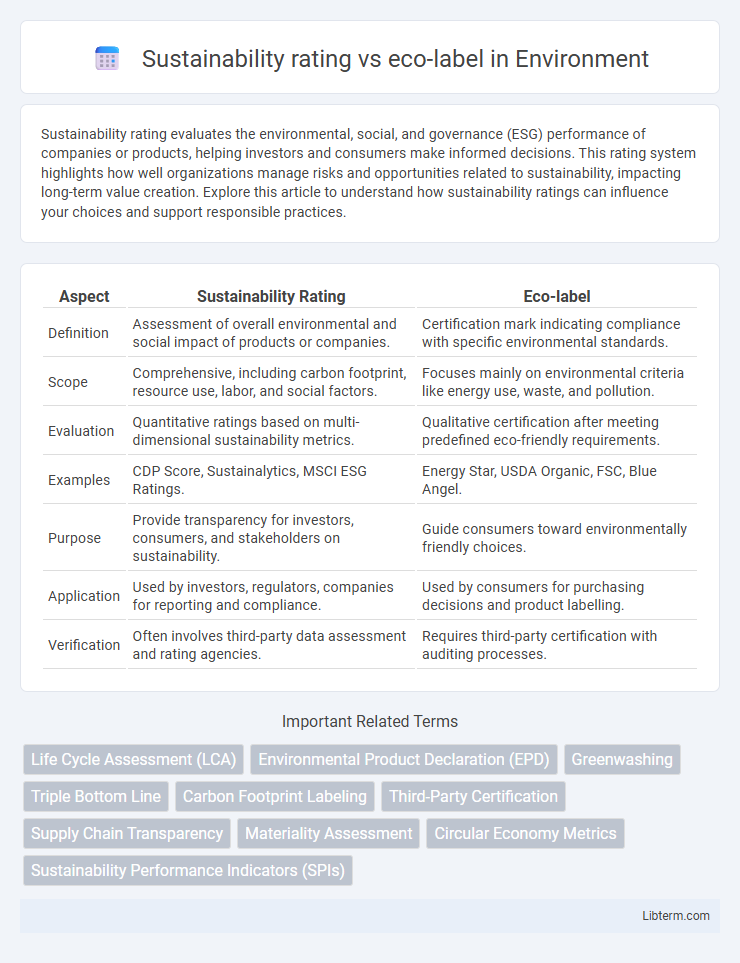Sustainability rating evaluates the environmental, social, and governance (ESG) performance of companies or products, helping investors and consumers make informed decisions. This rating system highlights how well organizations manage risks and opportunities related to sustainability, impacting long-term value creation. Explore this article to understand how sustainability ratings can influence your choices and support responsible practices.
Table of Comparison
| Aspect | Sustainability Rating | Eco-label |
|---|---|---|
| Definition | Assessment of overall environmental and social impact of products or companies. | Certification mark indicating compliance with specific environmental standards. |
| Scope | Comprehensive, including carbon footprint, resource use, labor, and social factors. | Focuses mainly on environmental criteria like energy use, waste, and pollution. |
| Evaluation | Quantitative ratings based on multi-dimensional sustainability metrics. | Qualitative certification after meeting predefined eco-friendly requirements. |
| Examples | CDP Score, Sustainalytics, MSCI ESG Ratings. | Energy Star, USDA Organic, FSC, Blue Angel. |
| Purpose | Provide transparency for investors, consumers, and stakeholders on sustainability. | Guide consumers toward environmentally friendly choices. |
| Application | Used by investors, regulators, companies for reporting and compliance. | Used by consumers for purchasing decisions and product labelling. |
| Verification | Often involves third-party data assessment and rating agencies. | Requires third-party certification with auditing processes. |
Introduction to Sustainability Ratings and Eco-Labels
Sustainability ratings assess the environmental, social, and governance (ESG) performance of products or companies using comprehensive criteria and quantitative metrics. Eco-labels, such as Energy Star or Fair Trade, certify products that meet specific environmental or ethical standards based on established guidelines. Both tools guide consumers toward more sustainable choices, with sustainability ratings providing broader evaluations and eco-labels offering product-specific endorsements.
Defining Sustainability Ratings
Sustainability ratings evaluate an organization's overall environmental, social, and governance (ESG) performance using comprehensive criteria and quantitative metrics. Eco-labels certify specific products or services that meet predetermined environmental standards, often verified by third-party organizations. Defining sustainability ratings involves assessing a broad spectrum of factors, such as carbon footprint, resource efficiency, and social impact, to provide stakeholders with transparent and comparable insights into sustainable practices.
What Are Eco-Labels?
Eco-labels are third-party certifications that verify a product or service meets specific environmental and sustainability criteria, helping consumers identify eco-friendly choices. These labels focus on particular attributes such as organic ingredients, carbon footprint reduction, or ethical sourcing, providing transparent information about environmental impact. Unlike broader sustainability ratings that evaluate overall company practices, eco-labels target product-level environmental performance and encourage responsible consumption.
Key Differences Between Sustainability Ratings and Eco-Labels
Sustainability ratings evaluate the overall environmental, social, and economic performance of products or companies using comprehensive criteria and third-party assessments. Eco-labels specifically certify that products meet predefined environmental standards, offering a visible assurance of eco-friendliness to consumers. Ratings provide a detailed score or rank reflecting broader sustainability impacts, while eco-labels signify compliance with targeted environmental criteria.
Criteria Used in Sustainability Ratings
Sustainability ratings evaluate companies or products based on comprehensive criteria including environmental impact, social responsibility, and governance practices, utilizing quantitative data and third-party audits to ensure objectivity. Eco-labels typically focus on specific environmental criteria such as carbon footprint, resource efficiency, or toxin reduction, often verified through certification processes aligned with industry standards. The more holistic approach of sustainability ratings contrasts with the targeted focus of eco-labels, influencing consumer trust and corporate accountability differently.
Standards and Certification in Eco-Labeling
Sustainability ratings and eco-labels both rely on rigorous standards and certification processes to verify environmental claims, ensuring transparency and consumer trust. Eco-labels typically adhere to recognized standards such as ISO 14024, involving third-party certification to validate product sustainability across life cycle stages. Sustainability ratings aggregate diverse criteria and data, often incorporating multiple certification frameworks to provide comprehensive assessments of environmental performance.
Transparency and Credibility Issues
Sustainability ratings provide quantifiable assessments based on standardized criteria, offering greater transparency through detailed methodologies and data disclosure, whereas eco-labels often rely on certification processes that can vary widely in rigor and criteria, potentially compromising credibility. Transparency issues arise when eco-labels lack clear public access to their evaluation procedures, limiting consumer ability to verify claims. Credibility concerns persist with eco-labels susceptible to greenwashing, while sustainability ratings backed by independent audits tend to foster stronger consumer trust and accountability.
Consumer Trust and Market Impact
Sustainability ratings provide quantifiable assessments of a company's environmental and social performance, enhancing consumer trust through transparency and standardized metrics. Eco-labels function as certification marks that verify a product's adherence to specific ecological criteria, directly influencing purchasing decisions by signaling credible environmental responsibility. Both tools drive market impact by encouraging businesses to improve sustainability practices and by empowering consumers to choose environmentally friendly products confidently.
Challenges and Limitations of Both Approaches
Sustainability ratings and eco-labels face challenges such as inconsistent criteria and lack of standardization, which can confuse consumers and undermine trust. Ratings often struggle with transparency and complex methodologies, while eco-labels may suffer from limited scope and regional variability. Both approaches must address issues of greenwashing and ensure rigorous auditing to enhance credibility and effectiveness in promoting sustainable practices.
Future Trends in Sustainable Product Assessment
Future trends in sustainable product assessment emphasize the integration of sustainability ratings and eco-labels to provide more comprehensive evaluations of environmental impact. Advanced data analytics and blockchain technology enhance transparency and traceability, enabling consumers to make informed decisions based on verified sustainability credentials. The convergence of these tools supports dynamic, real-time updates to sustainability performance, promoting continuous improvement across supply chains.
Sustainability rating Infographic

 libterm.com
libterm.com